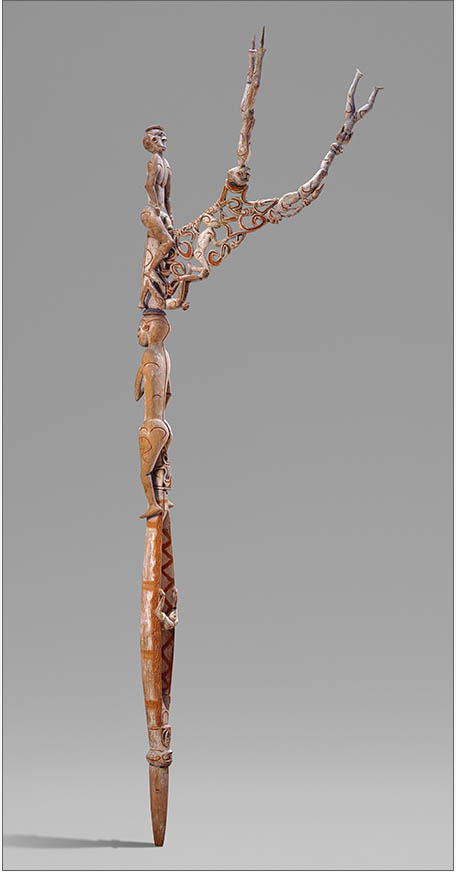 In 2007, the Metropolitan Museum opened new permanent galleries for Oceanic art, including a beautiful installation of the bis-poles, or ancestor poles, of the Asmat people of New Guinea. The Asmat live in some of the most primitive surroundings of any people, but the native Asmat carver, or wow-ipit, is among the world’s most accomplished artists.
In 2007, the Metropolitan Museum opened new permanent galleries for Oceanic art, including a beautiful installation of the bis-poles, or ancestor poles, of the Asmat people of New Guinea. The Asmat live in some of the most primitive surroundings of any people, but the native Asmat carver, or wow-ipit, is among the world’s most accomplished artists.Culturally, the Asmat, who live in the marshy lowlands, are related to the people of Oksapmin in the highlands that Arnold Perey writes about in Gwe: Young Man of New Guinea. They are a warlike people that at one time practiced cannibalism and head-hunting. These ancestor poles were then used in organizing raids on other villages, but in their imposing height and elegant carving are they also beautiful. And here, in the group, is one that seems to have the purpose of criticizing the others.
The ancestor pole is carved from a single piece of wood. According to traditions that Adrianus A. Gebrands and Pauline van der Zee have described, bands of men in warrior dress in a fleet of village war canoes would hunt the tree in the mangrove swamp. They would kill it and strip it of its bark and branches, causing it to bleed a red, bloodlike sap, and cut off all but one of its large aerial roots. Back in the village they would invert it, placing what is heaviest at the top.
Among the Asmat it is believed that no one dies a natural death, except infants and the very old. Traditionally, the spirit of the ancestor who is to be avenged sits at the top of the tree. A phallus-like projection arises from his body, and the expression on his face is one of fierce contempt.
Contempt was described by Eli Siegel, the founder of Aesthetic Realism, as "the disposition in every person to be for themselves by making less of the outside world."
But in this work, there is a relation of humility and pride that is very moving. A more peaceful expression is on the face of the ancestor. The great projection does not arise from his body. Instead, he is supported by it. He is also supported by a figure that stands backwards, in a show of modesty. At the bottom of the sculpture is a canoe, which according to tradition would have the figure of a captive in it. Instead we have a very lively monkey. Most surprising of all is the great projection. It divides, twists, is alive with figures, and goes into space through acrobatic forms. These figures playfully dance on their heads above the figure of the ancestor, as if to please him. They are beautiful.
In Is Beauty the Making One of Opposites, Eli Siegel asks this about heaviness and lightness:
Is there in all art, and quite clearly in sculpture, the presence of what makes for lightness, release, gaiety? – and is there the presence, too, of what makes for stability, solidity, seriousness? – is the state of mind making for art both heavier and lighter than that which is customary?
In this work we see that respect, the art way of seeing, criticizes contempt, making lightness and release and weight and seriousness more truly one.
But in this work, there is a relation of humility and pride that is very moving. A more peaceful expression is on the face of the ancestor. The great projection does not arise from his body. Instead, he is supported by it. He is also supported by a figure that stands backwards, in a show of modesty. At the bottom of the sculpture is a canoe, which according to tradition would have the figure of a captive in it. Instead we have a very lively monkey. Most surprising of all is the great projection. It divides, twists, is alive with figures, and goes into space through acrobatic forms. These figures playfully dance on their heads above the figure of the ancestor, as if to please him. They are beautiful.
In Is Beauty the Making One of Opposites, Eli Siegel asks this about heaviness and lightness:
Is there in all art, and quite clearly in sculpture, the presence of what makes for lightness, release, gaiety? – and is there the presence, too, of what makes for stability, solidity, seriousness? – is the state of mind making for art both heavier and lighter than that which is customary?
In this work we see that respect, the art way of seeing, criticizes contempt, making lightness and release and weight and seriousness more truly one.